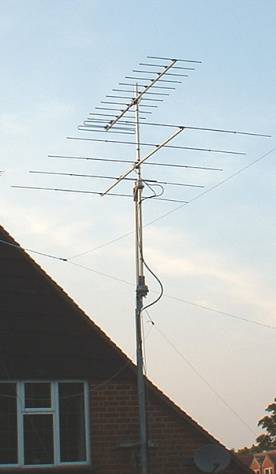Owing to the deficiencies of solution #2 a re-evaluation took place. I eventually decided that the only sensible solution was to invest in a commercial solution. I reasoned that as the other systems had been in place for twenty seven years without complaint* it was unlikely that anyone would complain if I kept it, initially anyway, "like for like". For this reason I opted for a 10 metre Adapt-a-mast, from Tennamast, with a tilt kit and quick release wall bracket. This option was attractive as the casing has reasonably small dimensions and in its collapsed state the mast is 19 feet 9 inches long, so to a casual viewer the rotator and antennas will be at exactly the same height as with the previous scaffold pole systems. The mast was ordered and delivered on time. One thing to bear in mind is that the mast is heavy - 70kg and the quick release wall bracket weighs in at around 15kg. The installation procedure should be fairly self evident but I did spend some time planning the sequence of assembly. I had two concerns. Firstly, how difficult was it going to be to undo the Rawlbolts and remove th15kg wall bracket in place while I marked the position of its five mounting bolts. |
|
| * I think it was fortunate that different neighbours had moved in during the intervening twenty years of inactivity and even if suspicious about the aerial they did not suffer and TVI/BCI and just got used to it being there | |
| The
first concern turned out to be no problem at all. When I installed the
K bracket originally I had put a coating of grease over the exposed threads
and this had lasted the course. A socket with ratchet soon had all three
nuts and the bracket removed. The second problem was now solved. I removed two of the Rawlbolts but left one sticking out of the wall. I waited until the neighbour on that side of the house went shopping and then climbed a ladder, hooked the centre hole of the new wall bracket over the still in place Rawlbolt. That took the main weight of the bracket. I was then able to check for level and mark the position of the other four mounting holes. Armed with a new masonry drill the holes were drilled, Rawlbolts fitted and new bracket in place in less than half an hour, before the shoppers returned. The next task was to mount the winch wall bracket. |
 |
| Armed
with another new masonry drill the position of the winch bracket was marked,
holes drilled and the bracket and winch attached. Now, as I indicated the mast weighs 70kg so I threaded the winch cable through the pulley on the wall bracket and back down to the mast lying on the ground. The cable was attached to the mast using the supplied fitting and the winch used to gradually lift the mast into an almost vertical position. With the main weight of the mast being taken on the winch it was possible to man handle the mast into the opening in the wall bracket. It must be said the the whole thing was rather precarious at this time but it did allow me to manoeuvre the base of the mast until it was perfectly vertical and mark the holes for the base plate. With the base plate firmly bolted down the the winch cable and quick release mechanism finally adjusted it was time to add the stub mast, rotator and, of course, the aerials. |
 |
|
The mast has been installed for over a year now and I have to say it is one of the best investments I have made. To luff the mast takes just a couple of minutes and, after practice, I can swap aerials for contests etc. in no more than 15 minutes - in fact it usually takes longer to remove the self amalgamating tape from the connectors than it does to physically swap the aerials. I
have received a couple of comments from the neighbours but only out
of curiosity - I just say that my hobby is listening to obscure radio
signals and that I'm getting old and that I wanted easier access for
maintenance. The best tactic is to start talking about listening to
radio waves bouncing off the trails of meteors - their eyes soon glaze
over and they can't wait to get away. Oh,
nearly forgot, spend some money on some decent coax. I use Ecoflex 10,
a good compromise between performance, price and size. |
 |
